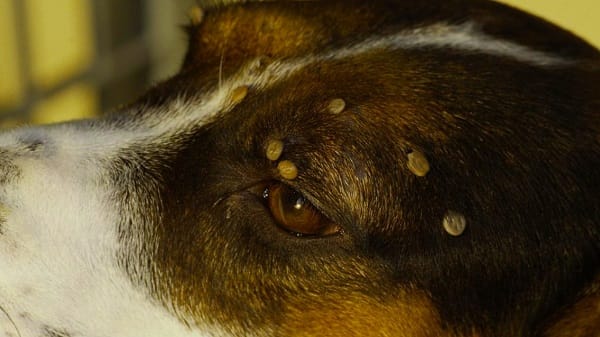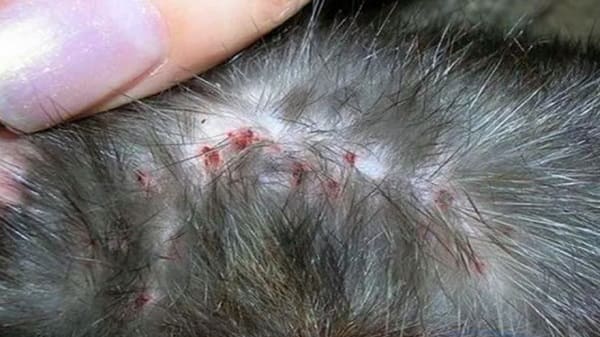Ticks are a common problem that many dog owners face. These tiny, blood-sucking parasites can be found in various environments and can pose a threat to your dog’s health. In this article, we will explore the topic of ticks on dogs, including what ticks look like, the types of ticks that can affect dogs, how to remove ticks safely, and the symptoms of tick bites.
What Does a Tick Look Like
Ticks are external parasites that attach themselves to the skin of animals, including dogs. They feed on blood and can transmit harmful diseases. Ticks can vary in size, ranging from as small as a pinhead to as large as a grape. They often latch onto areas with less fur, such as the ears, neck, belly, and armpits.

To identify ticks on your dog, run your fingers through their coat, feeling for any unusual bumps or small, raised areas. Ticks can be brown or black and may appear engorged if they have been feeding. They have eight legs and a tough outer shell, which protects them during feeding.
Types of Ticks On Dogs
There are various species of ticks, each with its unique characteristics. Common kinds of ticks that can affect dogs include the American dog tick, Asian longhorned tick, brown dog tick, deer tick (black-legged tick), rocky mountain wood tick, and lone star tick. These different ticks may vary in color, size, and preferred habitats.
Signs Your Dog has a Tick
Spotting the signs of a tick infestation in your dog is crucial for prompt action and appropriate treatment. Let’s look at the various signs that indicate your dog may have a tick.

- Visual Inspection: Regularly inspect your dog’s fur and skin, paying attention to areas like the head, neck, ears, and paws.
- Unusual Itching or Scratching: Excessive scratching or biting at certain areas could indicate a tick infestation.
- Tick Bite Marks: Look for small, red bumps or irritated areas on your dog’s skin after potential tick exposure.
- Lethargy and Loss of Appetite: Sudden lack of energy or appetite may be a result of tick-borne illnesses.
- Swollen or Painful Joints: Joint inflammation can be a symptom of tick-borne diseases.
- Fever and Inflammation: Check for signs of fever, such as a warm nose or excessive panting, along with redness or swelling.
- Changes in Behavior: Tick bites can cause behavioral changes like aggression, anxiety, or irritability.
- Hair Loss and Skin Irritation: Ticks can lead to skin problems, such as redness, rashes, scabs, or bald patches.
- Weakness or Lameness: Tick-borne diseases can cause weakness, difficulty standing or walking, and muscle or joint pain.
In rare circumstances, some ticks may inject a toxin into your dog’s system. It can cause weakness and paralysis of your dog’s legs and body.
How to Remove a Tick On Dogs
Ticks can pose a threat to our furry friends, and it’s crucial to know how to remove them safely and effectively. Here’s a step-by-step guide to removing a tick from a dog:
- Find a Well-Lit and Comfortable Area: Prepare a well-lit area where you can safely remove the tick without any distractions.
- Put on Protective Gloves: Put on a pair of disposable gloves to protect yourself from potential contact with the tick and any pathogens it might carry.
- Restrain Your Dog: Hold your dog’s collar or leash securely to prevent any sudden movements during the removal process.
- Examine the Tick: Inspect the tick closely to determine its size and engorgement. This information may be relevant when discussing the situation with your veterinarian.
- Use Tweezers to Remove the Tick: Take hold of the tick as close to your dog’s skin as possible using fine-tipped tweezers. Slowly and gently pull it upward with constant pressure, being careful not to twist or crush the tick.
- Disinfect the Bite Area: After removing the tick, clean the affected area with rubbing alcohol and apply antiseptic ointment to prevent infection.
- Dispose of the Tick Properly: Place the tick in a container with rubbing alcohol to kill it. Avoid crushing the tick with your fingers, as this may release disease-causing pathogens.
After removing the tick,monitor the bite area for any redness, swelling, or discharge. If you notice any concerning symptoms, contact your veterinarian promptly.
Tick Prevention Tips On Dogs
To safeguard your furry companion, it’s crucial to take preventive measures to reduce the risk of tick infestations. Here are some effective tick prevention tips to keep your dog safe and healthy.

Use Tick Preventives Ticks On Dogs
Consult your veterinarian to find the most suitable tick preventive product for your dog. There are various options available, including topical treatments, oral medications, and tick collars.
Avoid Tick-Infested Areas Ticks On Dogs
Ticks thrive in certain environments, such as tall grass, wooded areas, and shrubs. When possible, avoid taking your dog to these high-risk areas. Stick to open, well-maintained spaces for walks and outdoor activities.
Check Your Dog Regularly
Perform thorough tick checks on your dog after each outdoor adventure, especially in areas where ticks are prevalent. Run your hands over their entire body, paying close attention to areas with less fur, such as the ears, neck, belly, and armpits. If you find any ticks, promptly remove them using fine-tipped tweezers or seek veterinary assistance if needed.
Treat all Household Pets with Ticks On Dogs
Don’t forget to treat all your pets for ticks and fleas regularly.

Even if your dog is well-protected, other pets in your household may still carry ticks. Treat them consistently to prevent the spread of ticks among your furry companions.
Maintain a Clean and Tidy Environment
To minimize the risk of tick infestations, keep your living space clean and tidy. Regularly vacuum floors, carpets, and furniture to remove any potential ticks or their eggs.
Clean and Wash Dog Bedding
Tick-infested bedding, furniture, and carpets can serve as hiding spots for ticks. Clean your dog’s bedding frequently, washing it in warm water to kill any ticks present.
Conclusion
Ticks on dogs can pose risks to their health and well-being. By understanding ticks, recognizing their appearance, implementing preventive measures, conducting regular tick checks, and safely removing ticks when found, you can protect your dog from the dangers associated with these parasites. Remember to consult with your veterinarian for personalized advice and recommendations tailored to your dog’s specific needs.

